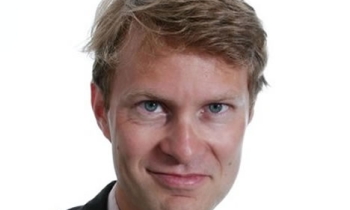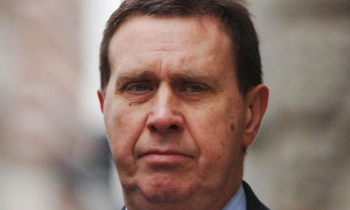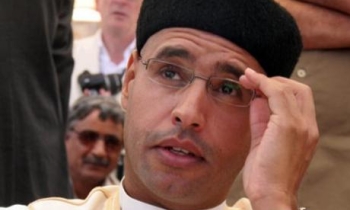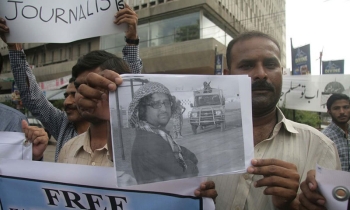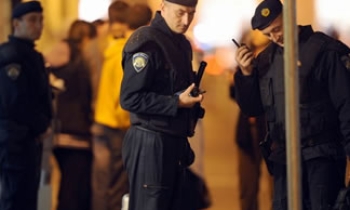Scenes from the front lines of the American Liberal Media Expeditionary Force’s campaign to rout the forces of conservatism:
- CNN, which right-wingers have been known to call the "Clinton News Network," chooses as its lead commentator for George W. Bush’s spring 2002 Middle East policy speech . . . Pat Robertson.
- On the crucial Manhattan front, New York magazine fields as its sole national correspondent one of the editors of The Weekly Standard; the New York Observer carries a regular column by a National Review editor; rabid liberal-hater Michael Kelly leaves his watch as The New Yorker’s Washington columnist to take over the "liberal" New Republic, then the "liberal" Atlantic, now columnizing in the "liberal" Washington Post – joined there by conservatives George Will, Robert Novak, Charles Krauthammer, and a guest battalion sermonizing on the wisdom of war with Iraq.
- Rock-and-decadence Rolling Stone holds down the culture-war front with conservatives P.J. O’Rourke and Tom Wolfe.
- In the Internet theater, genuinely liberal Salon includes among its cadre of columnists David Horowitz and Andrew Sullivan. Slate recruits a Weekly Standard editor as a regular, and even features articles by Charles Murray.
- On the networks: NBC uses Rush Limbaugh as an election analyst in 2002, Robert Bork as a commentator during the Clinton impeachment (ABC chooses William Bennett), and CBS rewards correspondent Bernard Goldberg for publishing an anti-CBS op-ed screed by moving him to a cushy job with better benefits.
With friends like these, my fellow liberals, who needs enemies?
Left and right today are not opposites. They are different species. It’s one of the best arguments to be found in Eric Alterman’s new book: in outlets classed by conservatives as liberal, and even in ones that are actually liberal, the other side is routinely invited in as part of the mix. In conservative publications, almost never.
It wasn’t always so. In the early decades of its existence the National Review frequently ran liberal, and even Marxist, writers, including John Kenneth Galbraith, Murray Kempton, and Eugene Genovese. When I had a chance to sit down with William F. Buckley a couple of years ago, I reminded him of that tradition, and lamented its passing. It turned out that recollection of same had escaped him: we never ran liberals, he told me. I wondered about the reason for the memory lapse: perhaps, at this late date – post-Whitewater, postimpeachment, in the full flower of Limbaughism – that there once was a time when conservatives could fraternize with liberals was literally unimaginable to them.
Why do the conservative media fight politics as a life-and-death struggle whereas an avowed leftist like me can look at an old tradition like National Review’s publishing liberals and conservatives side by side and think it’s kind of nifty? That contrast, between conservative bunkerism and liberal openness, speaks to the very structural heart of the difference between conservatives and liberals. We Americans love to cite the "political spectrum" as the best way to classify ideologies. The metaphor is incorrect: it implies symmetry. But left and right today are not opposites. They are different species. It has to do with core principles.
To put it abstractly, the right always has in mind a prescriptive vision of its ideal future world – a normative vision. Unlike the left (at least since Karl Marx neglected to include an actual description of the "dictatorship of the proletariat" within the 2,500 pages of Das Kapital), conservatives have always known what the world would look like after their revolution: hearth, home, church, a businessman’s republic. The dominant strain of the American left, on the other hand, certainly since the decline of the socialist left, fetishizes fairness, openness, and diversity. (Liberals have no problem with home, hearth, and church in themselves; they just see them as one viable life-style option among many.) If the stakes for liberals are fair procedures, the stakes for conservatives are last things: either humanity trends toward Grace, or it hurtles toward Armageddon.
This is why conservatives spy left-wing authoritarians everywhere. Seeing the world in terms of norms and presuming others do the same, they easily mistake a liberal tolerance for diverse options, even unconventional options, as an endorsement of the unconventional options. The presence of gay people on TV, for example, looks like a recommendation of homosexuality. That break in the natural order tempts chaos; chaos invites panic. Which is why conservatives fight by any means necessary to make the world look the way they insist it must look, while liberals are busy playing fair. And which is why it is now more accurate to say, as Eric Alterman, The Nation columnist and MSNBC.com blogger, does, that even as it "so perfectly contradicts conventional wisdom . . . the bias of the American media is more conservative than liberal." They fight the media war ruthlessly, and they are winning.
How have they done it? One way is by lying. James Baker convinced the press of the Democrats’ "unending legal wrangling" in the Florida recount fiasco of 2000 before the Democrats had filed a single lawsuit (the Republicans had filed all of them). Another way is by cheating. When Charles Murray’s Losing Ground was published in 1984, conservative backers paid pundits up to $1,500 each to attend a weekend seminar where Murray massaged them with his argument that federal antipoverty programs increased poverty – a claim that, once scholars had time to examine it but after all the fulsome columns were written, proved to be nonsense. (The same process repeated itself when Murray’s The Bell Curve was published ten years later.) And they’ve won by propounding a Big Lie – the kind that, simply by getting repeated so often, feels so true that those who claim it false look like wreckers and lunatics. "There are certain facts of life so long obvious they would seem beyond dispute," it runs. "One of these is that there is a left-wing tilt in the media."
Alterman says that’s dead wrong. For many, that will seem an amazing claim to make. But even more amazing is the evidence he adduces to prove that liberals don’t run the media: he quotes conservatives admitting it. "I’ve gotten balanced coverage," Patrick Buchanan said of his 1996 presidential campaign, "and broad coverage – all we could have asked. For heaven’s sakes, we kid about the liberal media,’ but every Republican on earth does that." The conservative press, Republican über-activist Grover Norquist points out, unlike the so-called liberal media (Alterman fliply refers to them throughout as the "SCLM"), "is self-consciously conservative and self-consciously part of the team." Like any classic Big Lie, the one about the so-called liberal media is based on strategic calculation: calling the media liberal works. I don’t think any conservatives would try to argue that the media have become more liberal in the last decade or so; yet Alterman cites one recent study that found a "fourfold increase in the number of Americans telling pollsters that they discerned a liberal bias in the news" compared to twelve years ago. But only the most foolish conservatives would attempt to argue that this finding reflects an objective increase in media liberalism in the intervening years.
The test of any case involving measurement of ideological influence is how that influence affects those in the center – for the people who aren’t already on the extremes are the ones who move most when the balance tips. And to be sure, a figure like Ann Coulter is burned mercilessly in What Liberal Media? What Alterman refers to as her "Tourette’s outbursts" – Coulter has a compulsion to call for liberals’ deaths – should be enough to discredit her; he also provides a handy online appendix (see WhatLiberal Media.com) cataloging the ungodly train of errors in her book Slander. Same with Bernard Goldberg. Alterman reminds us that Goldberg’s claim that only conservatives are condescendingly identified as ideologues on network TV ("conservative judge Robert Bork," as opposed to "Harvard law professor Lawrence Tribe") has been statistically disproved more than once, though it’s still treated as gospel. And there is a thick, fine chapter on "The (Really) Conservative Media," detailing the extent to which self-consciously conservative organs alone represent a sizable chunk of our media firmament. But Alterman’s real flames are reserved for the way moderate journalists, some of whom sometimes even get pigeonholed as liberals, have adjusted their professional standards to get conservatives taken seriously. Sweat, Howard Kurtz: your fawning profiles of conservative lights like Andrew Sullivan, Sean Hannity, and Bill Kristol earn you deserved comparison to the writers at Tiger Beat magazine. Kindly turn in your deanship, David Broder: your constitutional antipathy for the alleged disruptiveness of the left is rarely matched in your assessments of the right. Gray Lady, some things are not fit to print – like when you reported that Ken Lay slept in the Lincoln Bedroom as a guest of President Clinton after the claim appeared, unsourced and untrue, on the Drudge Report.
Alterman’s research, really, is excellent; his unique contribution to this debate is his dedicated trawling of transcripts for those moments when pundits reveal their inane prejudices during the endless stretches of air they have to fill on cable TV. (In a section on how journalists allowed their personal antipathy to shockingly bias their political coverage of Al Gore, he catches a 1999 Chris Matthews logorrhea on the subject of Gore’s three-button suit: "Is there some hidden Freudian deal here or what? I don’t know, I mean, Navy guys used to have buttons on their pants. I don’t know what it means.") It’s stunning to revisit the vitriol of the powerful Michael Kelly on the subject of Bill Clinton, the caving of journalists before the Bush administration during the War on Terrorism (Cokie Roberts of SCLM standby NPR on the subject of Donald Rumsfeld: "[I’m] a total sucker for the guys who stand up with all the ribbons on and stuff, and they say it’s true and I’m ready to believe it"), and the systematic collapse of journalistic probity during the high-tech economic boom times of the late nineties. MARKETS SURGE AS LABOR COSTS STAY IN CHECK, ran one front-page New York Times headline on April 30, 1997 – which would be the way the propagandists in George Orwell’s 1984 might translate the phrase "The Rich Got Richer While Poor Got Poorer."
It’s even more stunning – an argument clincher, in fact – to read what Republicans were saying in the run-up to Election Day 2000: they acknowledged plans, if Bush won the popular vote and Gore won the electoral college, to fight the outcome to the point of rendering Gore’s presidency illegitimate in the eyes of the public. (Chris Matthews endorsed this with the backassward presumption that, "Knowing him as we do," Gore "may have no problem taking the presidential oath after losing the popular vote.") After Election Day, the press bent over backward to treat Bush like the president-elect when he wasn’t, and savaged Al Gore for not conceding the "fact" outright. Alterman even quotes self-described liberal pundits Richard Cohen and Al Hunt making the astonishing argument that everyone should be happy at Bush’s election, because "Bush would be better at . . . restraining the GOP Dobermans." An acknowledgment, in other words, that a whip-sawing Republican tail deserves to wag the majoritarian dog. History, looking at the 2000 election, will not treat this profession kindly.
Much of this isn’t new – he leans often on work by Kathleen Hall Jamieson, Salon’s Eric Boehlert, and tips his hat frequently to contributors to these pages; he also borrows often from his own Sound and Fury: The Making of the Punditocracy. All the same it’s great having all this stuff rounded up in one place.
What this generation’s ruthless conservatives were able to do was exploit that organic, if diffuse, moodThere are flaws: the production feels a bit hasty (he reports on events that happened only six weeks before I received the galleys, a remarkably fast turnaround), he’s nasty in an ad hominem way to those on the left he disagrees with, he occasionally calls the kettle black (shortly before a chapter entitled "You’re Only As Liberal As The Man Who Owns You," he identifies himself as an "independent" Weblogger for General Electric’s MSNBC.com). Alterman’s style is a little grating. There’s lots of throat-clearing and digressing, and he betrays a smarmily knowing insider’s tone, referring throughout to what "no one believes" and what "we all know" – excluding, implicitly, those who don’t think like media types, the people whom it should be precisely part of the task of this book to try to understand. And here we get to the biggest problem of the book. The fact of the matter is that vast majorities of Americans don’t trust the media, that their dominant explanation as to why has to do with its so-called liberalism, and that such antipathy, though accelerated of late, certainly predates conservative movement attempts to exploit it. Why? Alterman doesn’t venture any ideas.
History would help. Though a historian himself (we all should look forward to his forthcoming book When Presidents Lie: Deception and Its Consequences, based on his Stanford dissertation), there’s none of it here. That hampers Alterman. At key points, he acknowledges the essential soundness of part of the conservatives’ argument: that there indeed exists a profoundly felt, and widespread, feeling of division between the cosmopolitan professionals of the media and what was messily but usefully labeled in 2000 America’s "red states" – especially so on the softer issues, the cultural issues. Bill O’Reilly may indeed talk like "an ignorant drunk." But an analytical question Alterman ignores is why he’s so damned popular. Coordinated conservative strategy is certainly not enough to explain it. For the image of the liberal media has stuck, partly, Alterman says, because of conservatives’ ceaseless bruiting of the charge; but it also has stuck because so many Americans never needed any prompting to perceive media denizens as brie-eaters, indifferent to culturally conservative values. This baseline middle-American distrust of the media that Alterman at key points forces himself to concede is hardly just a creation of conservative propaganda. The fact is that figures like O’Reilly have been a structural component of our civic life at least since 1968 – when a cultural resentment long and obscure in the gestation finally popped its chrysalis and took wing.
That was the year, at the height of the Vietnam War, that the Democrats held their national convention in Chicago, a makeshift band of left-wing protesters came to disrupt it – and the convention site was ringed by an unscalable barbed-wire fence, to be electrified, in case of emergency, at the flick of a switch. Perhaps a tenth of the protesters in their designated sites far from that hall were beaten by the rampaging Chicago police. That is well remembered. What is less well remembered is that one in five of the reporters and cameramen covering the event were sent to the hospital. At the convention site, Mike Wallace was socked in the jaw. There came a moment of extraordinary professional solidarity from the sachems of journalism in response. Arthur Ochs Sulzberger, Katharine Graham, Otis Chandler, executives from all three networks, and the editor in chief of Time jointly dispatched an unprecedented telegram to Mayor Richard J. Daley, accusing him of streetside censorship of a story "the American public as a whole has a right to know about."
Their response seemed to them merely common sense, a rallying point: they, after all, not Mr. Daley, were the trained, trusted experts on public opinion in this country. The police riot was clearly a travesty. "These," Tom Wicker wrote, "were our children in the streets, and the Chicago police beat them up." Who could disagree?
The guardians of public opinion were mistaken in their every assumption. For America did not see Chicago as Tom Wicker did; it saw it as Mayor Daley did. The bumper stickers showed it even before the polls: "We Support Mayor Daley and His Police."
Huge majorities blamed the protesters for their own fate, though many also blamed the media – CBS received thousands of calls accusing them of hiring cops to beat up the kids. Newsies suddenly awoke to find themselves hated the way bosses were hated. And the media’s inward, anguished, bending over backward to not appear liberal, which Alterman describes so effectively in the present day, was born. Not untypical was The Washington Post’s retrospectively exonerating the police, allowing that, "of course" policemen should be agitated by (no kidding) men in beards. Richard Nixon rode resentment of the media all the way to the White House that year; and, in 1972, to the greatest landslide in American electoral history (the conservative Nixon aide William Safire rode the media penitence all the way to the op-ed page of The New York Times.) A die was cast; conditions were set. The SCLM had been established in many Americans’ minds. What this generation’s ruthless conservatives were able to do was exploit that organic, if diffuse, mood; to make it stick long after it made any conceivable sense if it ever did.
And that’s where Alterman picks up the story: he surveys the damage. Like the news itself, What Liberal Media? is decidedly a first draft of a necessarily deeper inquiry into the whys and wherefores of a development central to understanding our politics over the last three-and-a-half decades. And that’s just fine, because when it comes to the present, Eric Alterman does a hell of a job taking the argument to a whole new level.

